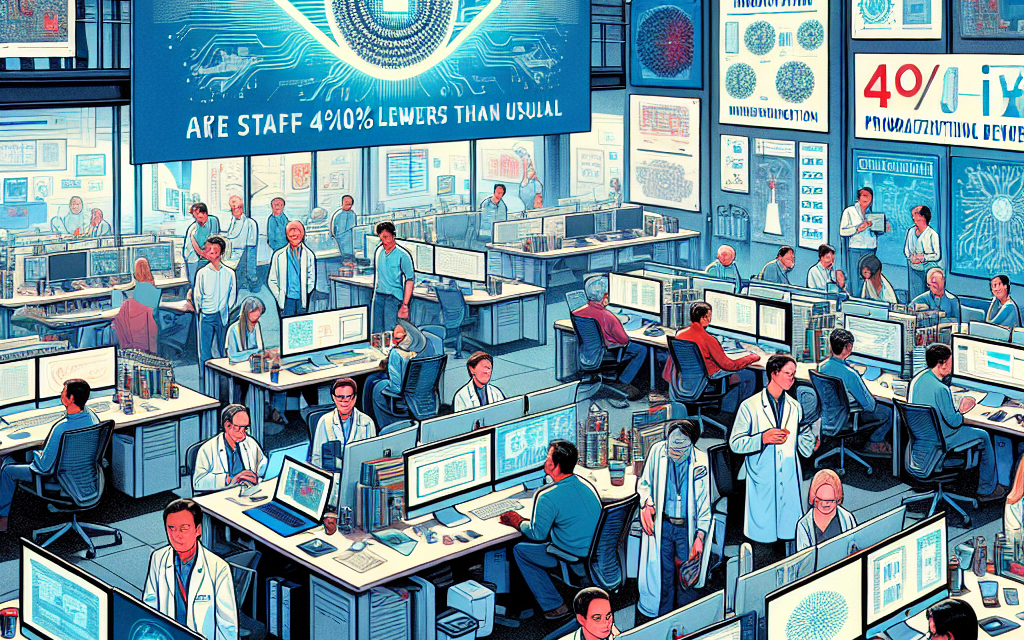“Streamlining Today, Innovating Tomorrow: AMD’s Strategic Shift Towards AI Excellence”
Introduction
Advanced Micro Devices (AMD), a leading player in the semiconductor industry, has announced a strategic decision to reduce its workforce by 4% as part of a broader initiative to prioritize innovation in artificial intelligence (AI) chip technology. This move underscores AMD’s commitment to strengthening its position in the rapidly evolving AI market, where demand for advanced computing capabilities is surging. By reallocating resources and focusing on AI chip development, AMD aims to enhance its competitive edge and drive future growth in a sector that is increasingly pivotal to technological advancement across various industries. The workforce reduction is part of a strategic realignment to ensure that the company can effectively channel its efforts and investments into areas with the highest potential for innovation and market impact.
Impact Of Workforce Reduction On AMD’s Market Position
Advanced Micro Devices (AMD), a prominent player in the semiconductor industry, recently announced its decision to reduce its workforce by 4% as part of a strategic initiative to prioritize innovation in artificial intelligence (AI) chip technology. This move, while significant, is not entirely unexpected given the rapidly evolving landscape of the tech industry, where AI is increasingly becoming a focal point for growth and development. The decision to streamline its workforce is aimed at reallocating resources and talent towards enhancing AMD’s capabilities in AI chip innovation, a sector that holds immense potential for future growth.
The impact of this workforce reduction on AMD’s market position is multifaceted. On one hand, the reduction in workforce may initially raise concerns among investors and stakeholders about the company’s operational capacity and morale. Workforce reductions can often lead to disruptions in productivity and may affect the company’s ability to maintain its current level of service and product development. However, AMD’s strategic focus on AI chip innovation suggests a forward-thinking approach that could ultimately strengthen its market position in the long term.
By prioritizing AI chip development, AMD is positioning itself to capitalize on the burgeoning demand for AI technologies across various industries. The AI chip market is expected to experience substantial growth in the coming years, driven by advancements in machine learning, data analytics, and automation. By reallocating resources towards this high-growth area, AMD aims to enhance its competitive edge and capture a larger share of the market. This strategic pivot could potentially offset any short-term challenges posed by the workforce reduction.
Moreover, AMD’s decision to focus on AI chip innovation aligns with broader industry trends, where major tech companies are increasingly investing in AI research and development. This move is likely to resonate well with investors who are keen on supporting companies that are at the forefront of technological advancements. By demonstrating a commitment to innovation, AMD can bolster investor confidence and potentially attract new investments, thereby enhancing its financial standing and market position.
In addition to financial implications, the workforce reduction and subsequent focus on AI innovation may also impact AMD’s corporate culture and internal dynamics. The company will need to manage this transition carefully to ensure that remaining employees are motivated and aligned with the new strategic direction. Effective communication and support during this period will be crucial in maintaining employee morale and productivity. By fostering a culture of innovation and adaptability, AMD can leverage its human capital to drive its AI initiatives forward.
Furthermore, AMD’s strategic shift towards AI chip innovation could have ripple effects across the semiconductor industry. As AMD intensifies its focus on AI, competitors may also be prompted to accelerate their own AI development efforts, leading to increased competition and innovation within the sector. This could ultimately benefit consumers and businesses by driving advancements in AI technology and expanding the range of available solutions.
In conclusion, while AMD’s decision to reduce its workforce by 4% may present immediate challenges, the long-term benefits of prioritizing AI chip innovation could significantly enhance its market position. By aligning its resources with industry trends and focusing on high-growth areas, AMD is poised to strengthen its competitive edge and capitalize on the opportunities presented by the rapidly evolving AI landscape. As the company navigates this transition, effective management and communication will be key to ensuring a successful outcome for both its employees and stakeholders.
Strategic Shift: AMD’s Focus On AI Chip Innovation
Advanced Micro Devices (AMD), a leading player in the semiconductor industry, has announced a strategic decision to reduce its workforce by 4% as part of a broader initiative to prioritize innovation in artificial intelligence (AI) chip technology. This move underscores the company’s commitment to staying at the forefront of technological advancements in an increasingly competitive market. By reallocating resources and focusing on AI chip development, AMD aims to enhance its product offerings and maintain its competitive edge.
The decision to reduce the workforce, while difficult, is a calculated step towards optimizing the company’s operations and aligning its resources with strategic priorities. In recent years, the demand for AI-driven solutions has surged, driven by advancements in machine learning, data analytics, and automation. Recognizing this trend, AMD is channeling its efforts towards developing cutting-edge AI chips that can meet the evolving needs of various industries, from healthcare to automotive and beyond.
Transitioning to a more AI-focused strategy requires significant investment in research and development. By streamlining its workforce, AMD can allocate more resources to innovation, ensuring that it remains agile and responsive to market demands. This strategic shift is not merely about reducing costs but about positioning the company to capitalize on emerging opportunities in the AI sector. As AI continues to transform industries, the demand for specialized chips that can efficiently process complex algorithms and large datasets is expected to grow exponentially.
Moreover, AMD’s decision reflects a broader industry trend where technology companies are increasingly prioritizing AI capabilities. Competitors such as NVIDIA and Intel have also been investing heavily in AI chip technology, recognizing its potential to drive future growth. In this context, AMD’s focus on AI innovation is both a response to competitive pressures and a proactive measure to secure its position as a leader in the semiconductor industry.
The impact of this strategic shift extends beyond the immediate workforce reduction. By concentrating on AI chip development, AMD is poised to deliver products that offer enhanced performance, energy efficiency, and scalability. These attributes are crucial for meeting the demands of AI applications, which require immense computational power and efficiency. As a result, AMD’s innovations could play a pivotal role in enabling advancements in fields such as autonomous vehicles, smart cities, and personalized medicine.
Furthermore, AMD’s commitment to AI innovation aligns with broader societal trends towards digital transformation and automation. As businesses and governments increasingly adopt AI technologies to improve efficiency and decision-making, the demand for robust and reliable AI hardware solutions is set to rise. By positioning itself as a key player in this space, AMD is not only securing its future growth but also contributing to the technological advancements that are reshaping the world.
In conclusion, AMD’s decision to reduce its workforce by 4% is a strategic move aimed at prioritizing AI chip innovation. By reallocating resources towards research and development, the company is positioning itself to capitalize on the growing demand for AI-driven solutions. This shift reflects both a response to competitive pressures and a proactive strategy to maintain its leadership in the semiconductor industry. As AMD focuses on delivering cutting-edge AI chips, it is poised to play a significant role in driving technological advancements across various sectors, ultimately contributing to the broader digital transformation of society.
Workforce Reduction: A Necessary Move For AMD’s Future?
Advanced Micro Devices (AMD), a leading player in the semiconductor industry, has announced a strategic decision to reduce its workforce by 4%. This move, while difficult, is aimed at reallocating resources to prioritize innovation in artificial intelligence (AI) chip technology. As the demand for AI-driven solutions continues to surge, AMD is positioning itself to remain competitive in a rapidly evolving market. The decision to cut jobs is never taken lightly, but it is often deemed necessary to ensure long-term growth and sustainability.
In recent years, the semiconductor industry has witnessed a paradigm shift, with AI and machine learning technologies becoming increasingly integral to various sectors. From autonomous vehicles to advanced data analytics, AI applications are transforming industries and creating new opportunities for growth. Recognizing this trend, AMD is focusing its efforts on developing cutting-edge AI chips that can meet the demands of this burgeoning market. By streamlining its workforce, the company aims to allocate more resources towards research and development, thereby accelerating its innovation pipeline.
The decision to reduce the workforce is part of a broader strategy to optimize operations and enhance efficiency. In a highly competitive industry, companies must continually adapt to changing market dynamics. For AMD, this means not only investing in AI technology but also ensuring that its organizational structure is aligned with its strategic objectives. By reducing its workforce, AMD can redirect funds towards critical areas such as AI chip design and development, which are essential for maintaining its competitive edge.
Moreover, the workforce reduction is expected to result in significant cost savings, which can be reinvested into the company’s core areas of focus. This financial flexibility will enable AMD to explore new partnerships, expand its product offerings, and enhance its market presence. In an industry where innovation is key to success, having the financial resources to invest in new technologies is crucial. Therefore, while the decision to cut jobs is challenging, it is a calculated move to ensure AMD’s future growth and competitiveness.
It is important to note that AMD’s decision is not an isolated case within the tech industry. Many companies are reevaluating their workforce strategies to better align with their long-term goals. As technology continues to evolve at a rapid pace, businesses must be agile and responsive to market changes. For AMD, this means prioritizing AI chip innovation, which is expected to drive significant growth in the coming years.
In conclusion, AMD’s decision to reduce its workforce by 4% is a strategic move aimed at prioritizing AI chip innovation. While the decision involves difficult choices, it reflects the company’s commitment to staying at the forefront of technological advancements. By reallocating resources towards AI research and development, AMD is positioning itself to capitalize on the growing demand for AI-driven solutions. As the semiconductor industry continues to evolve, companies like AMD must make bold decisions to ensure their long-term success. Through this workforce reduction, AMD is taking a proactive approach to secure its future in an increasingly competitive market.
AMD’s AI Chip Development: What To Expect

Advanced Micro Devices (AMD), a leading player in the semiconductor industry, has announced a strategic decision to reduce its workforce by 4% as part of a broader initiative to prioritize the development of artificial intelligence (AI) chips. This move underscores the company’s commitment to staying at the forefront of technological innovation in an increasingly competitive market. As the demand for AI-driven solutions continues to surge, AMD’s decision reflects a calculated effort to reallocate resources towards areas with the highest potential for growth and impact.
The decision to cut jobs, while difficult, is aimed at streamlining operations and enhancing the company’s focus on AI chip development. By reallocating resources, AMD seeks to bolster its research and development capabilities, ensuring that it remains competitive in the rapidly evolving AI landscape. This strategic shift is not only a response to current market demands but also a proactive measure to position the company for future success. As AI technologies become more integral to various industries, the need for advanced chips that can efficiently process complex algorithms and large datasets is paramount.
In recent years, AMD has made significant strides in the AI sector, leveraging its expertise in high-performance computing to develop chips that cater to the needs of AI applications. The company’s Radeon Instinct line of GPUs, for instance, has been well-received for its ability to handle intensive AI workloads. However, as competitors like NVIDIA and Intel continue to innovate, AMD recognizes the necessity of accelerating its own advancements to maintain a competitive edge. By focusing on AI chip innovation, AMD aims to deliver products that not only meet but exceed the expectations of its customers.
Moreover, the decision to prioritize AI chip development aligns with broader industry trends. As AI becomes increasingly embedded in everything from autonomous vehicles to healthcare diagnostics, the demand for specialized hardware that can support these applications is expected to grow exponentially. AMD’s strategic pivot is thus a reflection of its understanding of these market dynamics and its commitment to addressing the needs of its clients. By investing in AI chip technology, AMD is positioning itself to capitalize on the opportunities presented by this burgeoning field.
In addition to enhancing its product offerings, AMD’s focus on AI chip development is likely to have a positive impact on its financial performance. As the company introduces new and improved products, it stands to benefit from increased sales and market share. Furthermore, by establishing itself as a leader in AI chip technology, AMD can attract new partnerships and collaborations, further solidifying its position in the industry. This strategic emphasis on AI not only promises to drive innovation but also to deliver tangible business results.
In conclusion, AMD’s decision to reduce its workforce by 4% in order to prioritize AI chip innovation is a strategic move that reflects the company’s commitment to staying ahead in a competitive market. By reallocating resources towards AI development, AMD is positioning itself to meet the growing demand for advanced chips that can support a wide range of AI applications. As the company continues to innovate and expand its product offerings, it is poised to play a pivotal role in shaping the future of AI technology. Through this focused approach, AMD aims to not only enhance its competitive standing but also to drive significant growth and success in the years to come.
Industry Reactions To AMD’s Workforce Reduction
The recent announcement by Advanced Micro Devices (AMD) to reduce its workforce by 4% has sent ripples through the technology industry, sparking a range of reactions from analysts, competitors, and employees alike. This strategic decision, aimed at reallocating resources to prioritize artificial intelligence (AI) chip innovation, underscores the growing importance of AI in the semiconductor industry. As AMD positions itself to compete more aggressively in the AI market, the move has been met with both understanding and concern.
Industry analysts have largely viewed AMD’s decision as a calculated risk. By focusing on AI chip development, AMD is aligning itself with a significant trend in the tech world, where AI capabilities are becoming increasingly crucial. The demand for AI chips is expected to surge as industries across the board integrate AI technologies into their operations. Consequently, AMD’s shift in focus is seen as a proactive step to capture a larger share of this burgeoning market. However, the reduction in workforce has raised questions about the potential impact on AMD’s existing product lines and customer service capabilities.
Competitors in the semiconductor industry are closely monitoring AMD’s restructuring. Companies like NVIDIA and Intel, which have already made significant strides in AI chip development, may view AMD’s move as a sign of intensifying competition. While AMD has been a formidable player in the CPU and GPU markets, its foray into AI chips could alter the competitive landscape. This development may prompt competitors to reassess their own strategies and investments in AI technology, potentially leading to a new wave of innovation and competition in the sector.
Employees within AMD have expressed mixed feelings about the workforce reduction. While some understand the necessity of adapting to market demands, others are concerned about job security and the potential loss of talent. The company has assured its workforce that the reduction will be managed through a combination of voluntary departures and strategic realignments, aiming to minimize disruption. Nevertheless, the announcement has inevitably led to uncertainty among employees, who are now navigating a period of transition.
In the broader context of the tech industry, AMD’s decision reflects a growing trend of companies prioritizing AI development. As AI continues to revolutionize various sectors, from healthcare to finance, the demand for specialized hardware to support AI applications is increasing. This shift is prompting companies to reevaluate their resource allocation and strategic priorities. AMD’s workforce reduction is a testament to the pressures companies face to remain competitive in an ever-evolving market.
Moreover, the decision has sparked discussions about the ethical implications of workforce reductions in the tech industry. As companies pivot towards new technologies, the balance between innovation and employment stability becomes a critical consideration. Stakeholders are calling for transparent communication and support for affected employees, emphasizing the need for responsible corporate practices during such transitions.
In conclusion, AMD’s decision to reduce its workforce by 4% to focus on AI chip innovation has elicited a range of reactions from industry players, employees, and analysts. While the move is seen as a strategic alignment with market trends, it also highlights the challenges and ethical considerations associated with workforce reductions. As AMD embarks on this new chapter, the industry will be watching closely to see how the company navigates the complexities of innovation and competition in the rapidly evolving tech landscape.
Balancing Innovation And Workforce: AMD’s New Strategy
Advanced Micro Devices (AMD), a leading player in the semiconductor industry, has announced a strategic decision to reduce its workforce by 4% as part of a broader initiative to prioritize innovation in artificial intelligence (AI) chip technology. This move underscores the company’s commitment to staying at the forefront of technological advancements while navigating the challenges of a rapidly evolving market. As the demand for AI-driven solutions continues to surge, AMD is positioning itself to capitalize on this trend by reallocating resources towards the development of cutting-edge AI chips.
The decision to reduce the workforce, while difficult, is a calculated step aimed at optimizing the company’s operational efficiency. By streamlining its workforce, AMD seeks to free up resources that can be redirected towards research and development in AI technology. This strategic realignment is expected to enhance the company’s ability to innovate and deliver high-performance AI chips that meet the growing needs of various industries, from data centers to consumer electronics.
In recent years, the semiconductor industry has witnessed a paradigm shift, with AI emerging as a key driver of growth and innovation. Companies are increasingly investing in AI technologies to gain a competitive edge, and AMD is no exception. By focusing on AI chip innovation, AMD aims to strengthen its position in the market and cater to the increasing demand for AI-powered applications. This strategic focus is not only a response to market trends but also a proactive measure to ensure long-term sustainability and growth.
Moreover, AMD’s decision reflects a broader industry trend where companies are prioritizing technological advancements over workforce expansion. As automation and AI continue to reshape the business landscape, organizations are compelled to adapt by reallocating resources towards innovation. This shift is indicative of a new era where technological prowess is paramount, and companies must continuously evolve to remain relevant.
While the workforce reduction may raise concerns about job security, AMD has emphasized its commitment to supporting affected employees through this transition. The company plans to offer severance packages, career counseling, and job placement assistance to help ease the impact on those affected. This approach highlights AMD’s dedication to maintaining a responsible and ethical stance during organizational changes.
Furthermore, AMD’s focus on AI chip innovation is expected to create new opportunities for growth and expansion. By investing in cutting-edge technology, the company is poised to tap into new markets and drive revenue growth. This strategic pivot not only aligns with AMD’s long-term vision but also positions the company to play a pivotal role in shaping the future of AI technology.
In conclusion, AMD’s decision to reduce its workforce by 4% is a strategic move aimed at prioritizing AI chip innovation. By reallocating resources towards research and development, the company seeks to enhance its competitive edge and capitalize on the growing demand for AI-driven solutions. While the workforce reduction presents challenges, AMD’s commitment to supporting affected employees underscores its dedication to responsible corporate practices. As the semiconductor industry continues to evolve, AMD’s focus on AI technology positions it for sustained growth and success in an increasingly competitive market. Through this strategic realignment, AMD is not only adapting to current market trends but also paving the way for future innovation and leadership in the AI chip sector.
Long-term Implications Of AMD’s Workforce Reduction
The recent announcement by Advanced Micro Devices (AMD) to reduce its workforce by 4% has sparked considerable discussion within the tech industry. This strategic decision, aimed at prioritizing AI chip innovation, reflects a broader trend among technology companies to realign resources in response to the rapidly evolving demands of artificial intelligence. As AMD positions itself to compete more aggressively in the AI sector, the long-term implications of this workforce reduction warrant careful examination.
To begin with, AMD’s decision underscores the growing importance of AI technology in shaping the future of computing. By reallocating resources towards AI chip development, AMD is acknowledging the transformative potential of AI across various industries. This move is likely to enhance the company’s competitive edge, as AI chips are increasingly becoming the cornerstone of modern computing infrastructure. As a result, AMD’s focus on AI innovation could lead to significant advancements in processing power and efficiency, thereby solidifying its position as a leader in the semiconductor industry.
However, the workforce reduction also raises concerns about the potential impact on employee morale and productivity. While the company aims to streamline operations and concentrate on strategic priorities, the loss of experienced personnel could pose challenges in maintaining the quality and continuity of existing projects. It is crucial for AMD to manage this transition carefully, ensuring that remaining employees are supported and motivated to contribute to the company’s new direction. Effective communication and transparent decision-making will be key in mitigating any negative effects on the workforce.
Moreover, the shift towards AI chip innovation may have broader implications for the semiconductor industry as a whole. As AMD intensifies its focus on AI, other companies may feel compelled to follow suit, leading to increased competition and accelerated technological advancements. This could result in a more dynamic and innovative market, ultimately benefiting consumers through improved products and services. However, it also raises questions about the sustainability of such rapid innovation, as companies must balance the pursuit of cutting-edge technology with the need for stability and long-term growth.
In addition to industry-wide effects, AMD’s workforce reduction may influence the broader labor market within the tech sector. As the company reallocates resources, there may be opportunities for displaced employees to transition into roles that align with the growing demand for AI expertise. This could lead to a shift in the skill sets that are most valued within the industry, with a greater emphasis on AI-related competencies. Consequently, educational institutions and training programs may need to adapt to prepare the future workforce for these emerging opportunities.
Furthermore, AMD’s strategic pivot highlights the importance of adaptability in an ever-changing technological landscape. Companies that can anticipate and respond to shifts in market demand are more likely to thrive in the long term. By prioritizing AI chip innovation, AMD is demonstrating its commitment to staying at the forefront of technological advancement. This proactive approach may serve as a model for other companies seeking to navigate the complexities of the digital age.
In conclusion, AMD’s decision to reduce its workforce by 4% in order to prioritize AI chip innovation carries significant long-term implications. While it presents challenges in terms of employee morale and industry competition, it also offers opportunities for growth and advancement. As the company embarks on this new strategic direction, its ability to manage these changes effectively will be crucial in determining its future success. Ultimately, AMD’s focus on AI innovation reflects a broader trend within the tech industry, underscoring the transformative potential of artificial intelligence in shaping the future of computing.
Q&A
1. **What is AMD’s recent workforce reduction plan?**
AMD plans to reduce its workforce by 4%.
2. **Why is AMD reducing its workforce?**
The reduction is aimed at prioritizing AI chip innovation.
3. **How many employees does AMD currently have?**
As of the latest data, AMD has approximately 15,500 employees.
4. **How many jobs will be affected by the 4% reduction?**
Approximately 620 jobs will be affected.
5. **What is the primary focus of AMD following the workforce reduction?**
The primary focus is on AI chip innovation.
6. **How does AMD’s workforce reduction align with industry trends?**
It aligns with a broader industry trend of focusing on AI and advanced technologies.
7. **What impact might this have on AMD’s market position?**
It could strengthen AMD’s position in the AI chip market by reallocating resources to innovation.
Conclusion
AMD’s decision to reduce its workforce by 4% is a strategic move aimed at reallocating resources to prioritize AI chip innovation. This restructuring reflects the company’s focus on enhancing its competitive edge in the rapidly growing AI market. By streamlining operations and concentrating efforts on AI technology, AMD aims to accelerate the development of advanced AI chips, potentially increasing its market share and driving future growth. However, the workforce reduction may also pose challenges, such as potential disruptions in current projects and impacts on employee morale. Overall, this decision underscores AMD’s commitment to positioning itself as a leader in AI innovation, aligning with industry trends and future demands.





